Überlastungsüberwachung |
Überlastungsüberwachungmodelle werden verwendet, um zu gewährleisten, dass die Einspeisemodule, Ballastmodule, Energiespeichermodule (ESM), Umrichter und Motoren nicht überhitzen, wenn sie für längere Zeit unter Überlastbedingungen (Anwendungsistwert > fortlaufender Sollwert) laufen. Die Werte für Dauerleistung sowie für Grenzeffektivstrom und -drehmoment decken die meisten Bedingungen ab. Wenn die Durchlaufzeit jedoch sehr lang ist, können die Grenz- und Durchschnittswerte herabgesetzt werden. Die Überlastungsüberwachung trägt dieser Situation durch Verwendung eines exponentiell gewichteten Zeitfaktors zum Überlastwert (dem Einsatzfaktor U) Rechnung.
 Beispielszenario: Umrichterüberlast unter
Verwendung von Ixt
Beispielszenario: Umrichterüberlast unter
Verwendung von Ixt
Daher beträgt der Umrichtereinsatzwert U = 10A / 7,5A x 100% = 133%. Da U > 100% befindet sich der Umrichter in einem Überlastzustand. Es sei festgehalten, dass 10A lediglich 50% des maximalen Ausgangsstroms des Umrichters darstellen. Wie in dem Schaubild unten gezeigt erreicht der Ixt-Wert in diesem besonderen Fall seinen Höchstwert bei 84%, so dass der Umrichter unterhalb seiner maximalen Sollinnentemperatur arbeitet.

Als nächstes betrachten Sie dasselbe Szenario wie oben, mit der Ausnahme, dass die Beschleunigungs- und Abbremsdauern von 1,5s auf 3s steigen. In diesem neuen Szenario überschreitet der Ixt-Wert des Umrichters 100% und erreicht einen Höchstwert von 107%. Das impliziert, dass der Umrichter überhitzt wird. Entweder muss der Umrichter vergrößert oder die Anforderungen der Anwendung verringert werden. Der Hauptpunkt ist hierbei, dass der Umrichter bei 133% seines Dauerbetriebsstromwertes noch funktioniert (Auslastung, U = 133%). Der Unterschied besteht in der Dauer des Überlastzustandes.
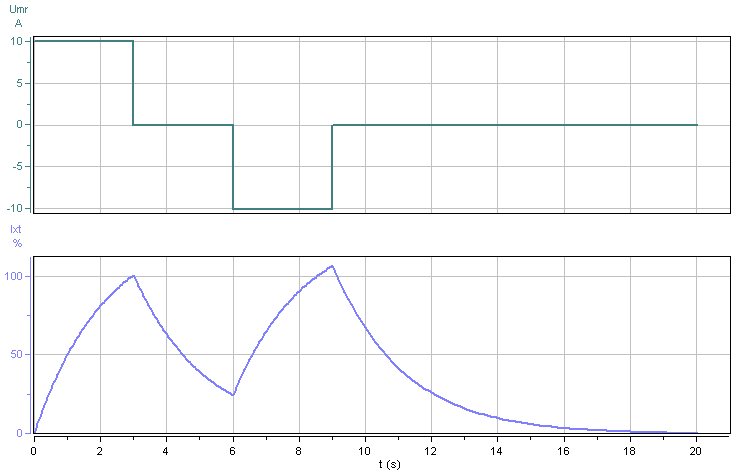
Das tatsächliche Ixt-Modell zu dem oben dargestellten Szenario wird unten abgebildet. Bei U = 133% erreicht der Ixt-Wert die 100%-Marke bei 2,9 s, was mit den obigen Ergebnissen übereinstimmt.

 Formulae
Formulae
 Einspeisemodul Pxt
Einspeisemodul Pxt
 Exponential
Tiered
Exponential
Tiered
The Exponential Tiered overload model is based on the Umax, Overload time (tOL) and Overload cycle time (tOLC) variables and uses an exponential decay model. Up to 3 different Pxt parameter sets can be defined. Only one Pxt parameter set is used depending on the Umax of the application, where the maximum application overload must be <= Umax. If only one Pxt parameter set is specified then Pxt this parameter set is always used. For this reason, Pxt0 should always be defined for the Inverter rated maximum power Pmax.
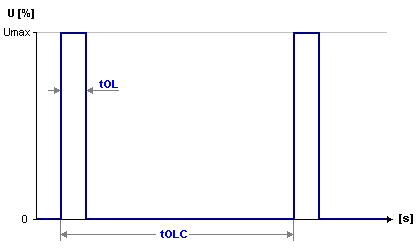
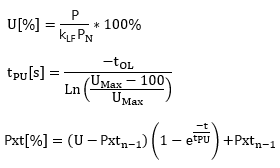
| Symbol | Description | Units |
|---|---|---|
| U | Utilization overload at sample [n] | % |
| P | Application power at sample [n] | W |
| PN | Rated continuous power | W |
| tOL | Overload time | s |
| tPU | Thermic constant | s |
| kLF |
Supply Voltage, Ambient Temperature & Elevation Load
Factors |
1 |
 Fast Slow
Fast Slow
The Fast Slow overload model is based on the Nominal Power, [PN], time constant [tc] and the exponent [x]. The program applies up to 3 Pxt models in parallel, and uses the higher value at each time sample in the cycle.
For a longer time constant, tc> 100s, usually one of the 3 Pxt models will have PN= Pcont, rated continuous power. Note that [PN] can be any value >0, when combined with [x] and [tc] that best fits the thermal modelling requirements for one of the key sub-components in the Infeed stage. Common values used by some manufacturers for a Fast Slow model are:
Fast: PN= 2*Pcont, x=1 and
tc= 5
Slow: PN= Pcont, x=1 and
tc= 400

| Symbol | Description | Units |
|---|---|---|
| P | Application power at sample [n] | A |
| PN | Nominal power | A |
| Pxtn-1 | Pxt value at previous sample [n-1] | % |
| x | Exponent (1 or 2) | 1 |
| tc | Time constant | s |
| VACN | Main supply nominal voltage | Vac |
| VDCN | DC Bus nominal voltage | Vdc |
| kLF |
Supply Voltage, Ambient Temperature & Elevation Load
Factors |
1 |
 Umrichter Ixt
Umrichter Ixt
 Exponential Tiered
Exponential Tiered
The Exponential Tiered overload model is based on the Umax, Overload time (tOL) and Overload cycle time (tOLC) variables and uses an exponential decay model. Up to 3 different Ixt parameter sets can be defined. Only one Ixt parameter set is used depending on the Umax of the application, where the maximum application overload must be <= Umax. If only one Ixt parameter set is specified then Ixt this parameter set is always used. For this reason, Ixt0 should always be defined for the Inverter rated maximum current Imax.

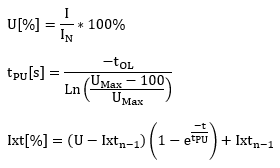
| Symbol | Description | Units |
|---|---|---|
| U | Utilization overload at sample [n] | % |
| I | Application current at sample [n] | A |
| IN | Rated continuous current | A |
| tOL | Overload time | s |
| tPU | Thermic constant | s |
| k |
De-rating factor k = kLF * kfHz |
1 |
| kLF | Ambient temperature and elevation Load Factor | 1 |
| kfHz |
Low Speed factor (0-5Hz) k=2/3 at standstill (0Hz) |
1 |
 Fast Slow
Fast Slow
The Fast Slow overload model is based on the Nominal Current, [IN], time constant [tc] and the exponent [x]. The program applies up to 3 Ixt models in parallel, and uses the higher value at each time sample in the cycle.
For a longer time constant, tc> 100s, usually one of the 3 Ixt models will have IN= Icont, which is the PWM frequency dependant rated continuous current. Note that [IN] can be any value >0, when combined with [x] and [tc] that best fits the thermal modelling requirements for one of the key sub-components in the inverter. Common values used by some manufacturers for a Fast Slow model are:
Fast: IN= 2*Icont, x=2 and
tc= 5
Slow: IN= Icont, x=2 and
tc= 400

| Symbol | Description | Units |
|---|---|---|
| I | Application current at sample [n] | A |
| IN | Nominal current | A |
| Ixtn-1 | Ixt value at previous sample [n-1] | % |
| x | Exponent (1 or 2) | 1 |
| tc | Time constant | s |
| k |
De-rating factor k = kLF * kfHz |
1 |
| kLF | Ambient temperature and elevation Load Factor | 1 |
| kFrml |
Derating Formula that can be a function of fHz = Inverter Output Frequency [Hz] If kFrml is empty, then kFrml= 2/3 (fHz = 0Hz) kFrml= 1 (fHz <> 0Hz) |
1 |
 Ballastmodul Bxt
Ballastmodul Bxt
Für die Ballastmodul gilt das Bxt-Modell

| Symbol | Bedeutung | Einheit |
|---|---|---|
| P | Application power at sample [n] | W |
| PN | Rated continuous power | W |
| tPU | Thermic constant | s |
| Rth | Thermal resistance to ambient | K/W |
| Cth | Thermal capacitance | J/K |
| Tmax | Resistor maximum temperature | oC |
| Tamb | Ambient temperature | oC |
| Wmax | Max energy dissipation | J |
| Bxtn-1 | Bxt value at previous sample [n-1] | % |
 Energiespeichermodul I2t
Energiespeichermodul I2t
Für die Energiespeichermodul (ESM) gilt das I2t-ESM-Modell

| Symbol | Bedeutung | Einheit |
|---|---|---|
| I | Anwendungsstrom bei Beispielzeit [n] | A |
| IN | Dauer-Nennstrom bei Nenndrehmoment und Drehzahl | A |
| IMax | Maximaler Nennstrom | A |
| tmax | Dauer bei maximalem Nennstrom | s |
| I2tn-1 | I2t-Wert bei vorheriger Beispielzeit [n-1] | % |
 Motor I2t
Motor I2t
Für die Motor gilt das I2t-Motor-Modell
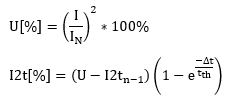

| Symbol | Bedeutung | Einheit |
|---|---|---|
| I | Anwendungsstrom bei Beispielzeit [n] | A |
| IN | Dauer-Nennstrom bei Nenndrehmoment und Drehzahl | A |
| In | Dauer-Nennstrom bei Drehmoment und Drehzahl | A |
| I0 | Nenndauerstrom im Stillstand | A |
| ∆t | Beispielzeit | s |
| tth | Thermische Zeitkonstante | s |
| I2tn-1 | I2t-Wert bei vorheriger Beispielzeit [n-1] | % |
| nh |
Geschwindigkeit bei homogener Wärmeverteilung bei |
U/min |